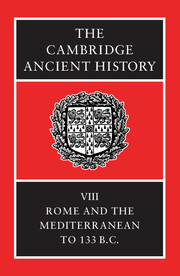Book contents
- Frontmatter
- Contents
- List of maps
- List of text-figures
- Preface
- 1 Sources
- 2 The Carthaginians in Spain
- 3 The Second Punic War
- 4 Rome and Greece to 205 B.C.
- 5 Roman expansion in the west
- 6 Roman government and politics, 200-134 B.C.
- 7 Rome and Italy in the second century B.C.
- 8 Rome against Philip and Antiochus
- 9 Rome, the fall of Macedon and the sack of Corinth
- 10 The Seleucids and their rivals
- 11 The Greeks of Bactria and India
- 12 Roman tradition and the Greek world
- 13 The transformation of Italy, 300 – 133 B.C. The evidence of archaeology
- Three Hellenistic Dynasties
- Genealogical Tables
- Chronological Table
- BIBLIOGRAPHY
- Index
- Map 11: Greece and Asia Minor
- Map 13: Asia Minor and Syria
- References
4 - Rome and Greece to 205 B.C.
Published online by Cambridge University Press: 28 March 2008
- Frontmatter
- Contents
- List of maps
- List of text-figures
- Preface
- 1 Sources
- 2 The Carthaginians in Spain
- 3 The Second Punic War
- 4 Rome and Greece to 205 B.C.
- 5 Roman expansion in the west
- 6 Roman government and politics, 200-134 B.C.
- 7 Rome and Italy in the second century B.C.
- 8 Rome against Philip and Antiochus
- 9 Rome, the fall of Macedon and the sack of Corinth
- 10 The Seleucids and their rivals
- 11 The Greeks of Bactria and India
- 12 Roman tradition and the Greek world
- 13 The transformation of Italy, 300 – 133 B.C. The evidence of archaeology
- Three Hellenistic Dynasties
- Genealogical Tables
- Chronological Table
- BIBLIOGRAPHY
- Index
- Map 11: Greece and Asia Minor
- Map 13: Asia Minor and Syria
- References
Summary
THE EARLIEST CONTACTS
The Romans had had state-to-state contacts, both friendly and unfriendly, with Greek communities and kings of the Greek world east of the Adriatic for many generations before the first trans-Adriatic military adventure in 229 B.C. At a different level, Italian traders were no strangers to the opposite coast of the Adriatic, and Greeks had maintained regular contacts with Italy even before the founding of the first permanent colony in Italy at Cumae in the mid eighth century B.C.; the Greeks of the colonial foundations of Italy had long been naval allies (socii navales); many Greek cities of Sicily were since 241 part of the first Roman province. Greek culture, the Greek language, the Greek way of life were thus all familiar to many, above all upper-class, Romans long before serious political engagement on the Balkan peninsula was even contemplated.
One must nevertheless beware of overemphasizing the nature and intensity of the earliest contacts with the eastern Greeks. Before 229 there was no Greek state east of Italy with which Rome had a contact which was more intense than amicitia – and amicitia was a global term for relationships which extended from the level of polite and distant friendliness to something approaching a recognition of common interests, in which case the relationship might conceivably be defined by a treaty. Amicitia could mean much or little; but for the eastern Greeks before 229 it meant without exception little.
At the religious and cultural level Rome was not above making a dedication in the Greek shrine at Delphi in 394, after her success at Veii. The dedication was made in the treasury of Massilia, which later claimed to have maintained a friendship with Rome since the Phocaean settlers put in at the mouth of the Tiber on their way to Massilia in the early sixth century.
Keywords
- Type
- Chapter
- Information
- The Cambridge Ancient History , pp. 81 - 106Publisher: Cambridge University PressPrint publication year: 1989
References
- 7
- Cited by

